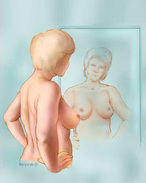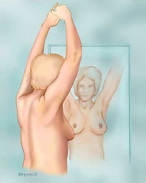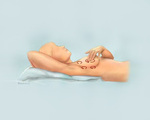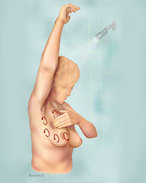The Five Steps of a Breast Self-Exam
|
Examining your breasts is an important way to find breast cancer early. Not every cancer can be found this way, but it is a critical step you can and should take for yourself. No woman wants to do a breast self-exam (BSE), and for many it is a frustrating experience. However, the more you examine your breasts, the more you will learn about them and the easier it becomes for you to tell if something unusual has occurred. Making a habit of doing a monthly self breast exam will help you to familiarize yourself with how your breasts normally look and feel. The best time to do a BSE is several days after the end of your period, when your breasts are the least likely to be swollen. If you are no longer having periods, choose a day that’s easy to remember, such as a birthday. It is important not to panic if you think you found something out of the ordinary. Most women have some lumps or lumpy areas in their breasts. Eight out of ten breast lumps that are removed are benign, non-cancerous. It is also important to keep in mind that changes can occur due to aging, your menstrual cycle, pregnancy, menopause, or birth control pills. Breasts tend to have different “regions.” The upper, outer area – around your armpit – tends to have the most prominent lumps and bumps. The lower half of your breast can feel like a sandy or pebbly beach. The area under the nipple can feel like a collection of large grains. Another part might feel like a lumpy bowl of oatmeal. It is important that you get to know the regions of your breasts. The better you know your breasts, the easier it is to tell if something has changed. You should inform your doctor if changes to your breast:
How to perform a Self Breast Exam Step 1 The first step is to look at your breasts in a mirror, with straight shoulders and your arms on your hips. You should look if:
If you see any of the following changes you should inform you doctor:
Step 2 and 3 Raise your arms and look for the same changes as you did in Step 1. While you’re at the mirror gently squeeze each nipple between your finger and thumb and check for nipple discharge (this could be a milky or yellow fluid, or even blood).
Step 4 Feel your breasts while lying down, using your right hand to feel your left breast and then your left hand to feel your right breast. Use a firm, smooth touch with the three middle fingers of your hands, keeping the fingers flat and together; use a circular motion. Check the entire breast from top to bottom, side to side – from your collarbone to the top of your abdomen, and from your armpit to you cleavage.
Step 5 Finally, feel your breasts while you are standing or sitting. Many women find that the easiest way to feel their breasts is when their skin is slippery, so they like do this step in the shower. Follow the same procedures an in Step 4.
|
(Souce of information: www.breastcancer.org)




